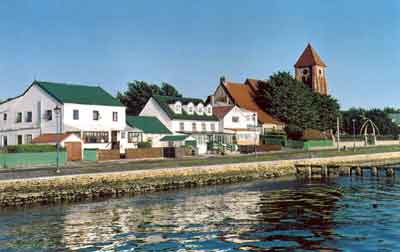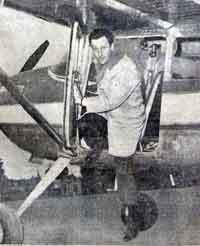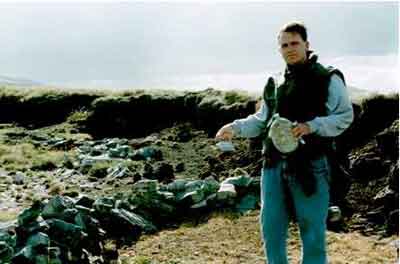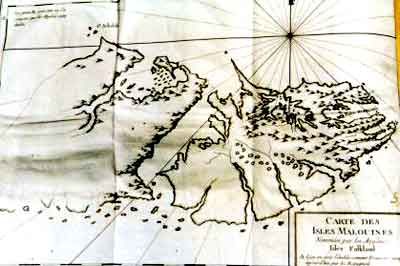|
The Falkland
Islands (in Spanish, Islas Malvinas) are an archipelago
in the South Atlantic, about 600 kilometres off the coast of
Argentina.
The islands were first occupied in 1764 by the French, who
handed over their settlement to the Spanish naval flotilla on
1 April 1767. British ousted the French settlers, and the
French sold their claim to Spain. In 1820 Argentina claimed
sovereignty as Spain's successor and have disputed Britain's
claim to the islands since 1833. There may have been Irishmen
among the crew of John Davies’s ship the Desire when he
discovered the
Islands in 1592, or in the Welfare of John Strong, the first
man to land on the Falklands/Malvinas in 1690. But if so, we
have no record of their names.
The first
recorded Irish visitor was Commander William Farmer, born in
Youghal, Co. Cork in 1732, who commanded the sloop Swift
in West Falkland (Gran Malvina) waters in 1770 and was
obliged to evacuate Port Egmont by a much larger Spanish force.
The next Irish name in Falklands/Malvinas history is that of
William Dickson of Dublin who was storekeeper for Louis Vernet’s
colonists, and was entrusted with the care of the British flag
by Captain Onslow after he landed at Port Louis in 1833. Dickson
was among those murdered by the gauchos led by Antonio Rivera on
26 August 1833.
The first
Falklands/Malvinas census, that taken by Lt. Governor Richard
Moody in 1842 noted five colonists born in Ireland. But the
Irish population was to increase sharply with the arrival of the
military pensioners in 1849. A large proportion of the Victorian
army came from Ireland and the 1851 census counts seventy-four
persons of the Irish nation: fifteen were military pensioners
and many of the rest their wives and children.
During the late
1840s, the second official in the
Islands was the Magistrate, William Henry Moore, who had left his practice (and
his wife) in Belturbet, Co. Cavan, and armed with a testimonial
signed by many of the
Dublin legal establishment, arrived in
Port Louis in
March 1845. Moore was a caricature provincial lawyer:
argumentative, self important, on the make and a heavy drinker.
He argued violently with the first two governors, Moody and
Rennie, and the former reported to
London
on 25 June 1846: “there are many Irishmen here, Mr. Moore is an
Irishman, and the observation has been made that we have a
'Daniel O’Connell' among us.” Moore eventually returned to
London on leave in 1849, and in a remarkable own goal, was
discovered offering legal advice to a company in dispute with
the Colonial Office. He was sacked and disappears from view in a
minor post in the Customs.
|

Port Stanley from the
Harbour Edge
(Anna King, www.falklandislandssgifts.com)
|
Since the late
1830s some Irish began sheep-farming in the Falkland/Malvinas
Islands. Among others, Thomas [Devil] Murray
(b. 1854) owned a large flock which he sold a few years later to
purchase land in the continent. Most of the these Irish were
Catholics, but other Catholics in the islands were English,
Chilean, French and from other countries. A fundamental part of
the life of Catholic islanders was the presence of priests among
them. The islands were (and still are) jurisdiction of
Propaganda Fide in Rome. In 1857 they wrote to Cardinal Wiseman,
archbishop of
Westminster,
and to Cardinal Alessandro Barnabo, Secretary of Propaganda
Fide, to ask for a priest to attend their souls. The archbishop
of Buenos Aires,
Dr. Mariano J. Escalada, requested Anthony Fahy O.P. (1805-1871)
to find a solution for the islanders, and he proposed that a
priest from
Buenos Aires
visit them once every seven years. That same year, Fr. Lawrence
Kirwan visited the islands and organized a committee to build a
chapel and obtain land for a cemetery. Among the committee
members were P.D. Lynch, Thomas Havers, Cristopher Murray, and
Patrick Maguire. In 1861, land was acquired to build a
Catholic chapel. In 1865 Fr. Patrick J. Dillon (1842-1889)
visited the islands. At that time there were about 200 Catholics
and they had no priest. Fr. Dillon spent a few months among them
and administered the sacraments. In 1872 Fr. William Walsh made
a short visit to the islands and before the end of the year he
was gone on his way to his diocese of
Brisbane
in Australia.
Fr. James Foran
was the first resident priest, and was fundamental in
establishing a Catholic position in the islands. He arrived in
October 1875 and, after receiving permission from ecclesiastical
authority, from 1880 to 1886 he spent half the year on the
islands and the other half on the mainland. On 15 June 1873,
Stella Maris chapel in
Port Stanley had been completed by the islanders, and later Fr. Foran
moved it to a better location. Fr. Foran also started a school
for Catholic children in the islands. When Fr. Foran finally
left the islands in April 1886 he travelled direct to
Buenos Aires
and eventually returned to England. After 1888, the Catholics of
the Falkland/Malvinas Islands were attended by the Salesian
Fathers, beginning with Fr. Patrick J. Diamond, who arrived on
19 April 1888 in Port Stanley together with Mgr. José Fagnano.
Fr. Diamond was
able to continue on the work which was carried out by Fr. Foran.
Fr. Diamond built the parish priest house and directed the
children's school. He also baptized sub conditione over
twenty-five Protestant adults. Fr. Diamond was followed in 1890
by Fr. Patrick O'Grady, who had been in
Argentina
since 1884. Fr. O'Grady replaced the old chapel by a new
building, which opened in 1899. Other chaplains were Fr. Mignone,
who remained in the islands until 1937, and Irish-born Fathers
Drumm and Kelly. In addition, other priests assisted the
resident clergy, including Mgr. Santiago M. Ussher in 1930, the
Passionists Fr. Domingo Moore and Fr. Santiago Deane, and the
Pallotine Fr. Celestino Butterly. The Salesian sisters Hijas
de María Auxiliadora, among them Sister Mary Jane Ussher,
established a mission in the islands and remained there for many
years.

Miguel L. Fitzgerald (b.
1926),
Irish-Argentine serial flyer to Falklands/Malvinas
Islands in 1964, 1968
(Crónica, 9 September 1964)
|
However, the
Irishman who made the greatest impact on the history of the
Islands was certainly Lowther Brandon, a
Church of
Ireland clergyman from Carlow who became Colonial Chaplain in
1877. A man of faith and drive, he was remarkable for tackling
the social problems of Stanley in a series of practical steps.
He founded the first savings bank, established abstinence
societies to combat drunkenness, and launched the Falklands
Islands Magazine, which he type set and printed himself. He
rode tirelessly around his broad parish, dragging after him a
pack horse (carguero) laden with his magic lantern for
shows to the camp settlements.
Brandon
also served as Inspector of the Government Schools and was a
constant advocate of better teaching for children in camp. He
returned to Ireland in 1907 and died in Slaney, Co. Wicklow in
1933.
Another
Irishman in a senior post in government was Doctor Samuel
Hamilton from Dublin who arrived in the islands in 1879 and
served there for twenty-five years, returning to Ireland to
retire. Prominent explorers who visited the Islands included
Captain Francis Crozier, from Banbridge, Co. Down, who commanded
one of the ships (Terror) on the Antarctic expedition of
1841-3 and Sir Ernest Shackleton, born in Athy, Co. Kildare, who
visited
Stanley
on numerous occasions on his way to Antarctica or returning.
Another explorer, the Irish yachtsman Conor O'Brien called at
Stanley and his boat remained in use in Falklands/Malvinas
waters until she was returned to the Irish Maritime museum.
Two British
governors came from Ireland, Thomas Fitzgerald Callaghan from
1877 to 1880 and Sir Cosmo Haskard, who served from 1964 to 1970
and has retired to
Ireland.
A third governor, Sir James O’Grady (1931 - 1935), was the son
of an Irish family living in England. He started life as a
jobbing carpenter, moved into trade union politics, was sent on
a diplomatic mission to Bolshevik Russia and was finally
appointed colonial governor, first to one of the Australian
states and then to the Falkland/Malvinas Islands.
During the
opening decades of the twentieth century, the conflict between
Argentina and England for the control of the Falkland/Malvinas
Islands gained a wider awareness among the Irish in Buenos Aires
and other provinces. The controversial and nationalistically
opinionated Fianna newspaper never missed an opportunity
to attack Britain's occupation of the islands. The integration
process of Irish Argentines to a larger and wider society
signified that most of them felt that their loyalty was towards
Argentina rather than Britain. Miguel L. Fitzgerald (b. 1926)
perhaps best epitomized that general Irish-Argentine attitude,
when twice flying from the mainland to the islands in 1964 and
1968. On both occasions he landed near
Stanley,
raised the Argentine flag and with accompanying journalists
tried (unsuccessfully) to interview British authorities. Nothing
was achieved by these individual actions, but they do reveal the
increasing nationalistic feelings of the Irish Argentines
towards the adopted country of their forefathers. In August
1966, another Irish Argentine, Eduardo F. McLoughlin (b. 1918) a
former Air Force officer, was appointed Argentine ambassador to
Britain; he would remain in London until 1970. Following
Argentine policy, McLoughlin interfered with a British plan to
hand sovereignty over to Falkland/Malvinas islanders before
1982, which would have opened the way to a pacific settlement of
the conflict.
|

In January 2000 Miguel
Savage returned to the position of the Argentine army
above Moody Brook (west of Port Stanley), where he was
stationed in June 1982. "The base of the machine gun was surrounded by
lethal craters. Nobody could have survived here. We found two 105-mm cannons. It's amazing that
one of them was carried by hand by six conscripts and
myself four kilometres upwards Moody Brook. We did it in
four days. Now they lie there like old dinosaur
skeletons" (Miguel Savage collection). |
The
Falkland/Malvinas War (2 April - 14 June 1982) began when the
Argentine military junta sent warships to land a party of scrap
dealers on South Georgia with the intention of reclaiming the
Falkland/Malvinas Islands. A full scale military invasion
followed. Attempts by the UN, the
US,
and Peru to secure a peaceful resolution to the conflict failed.
Britain dispatched a task force comprising some thirty warships,
two aircraft carriers, assorted fleet auxiliaries, the
Canberra (a requisitioned passenger liner), Ro Ro ferries and
container ships to recover the islands. The ten-week conflict
claimed the lives of nearly 1,000 British and Argentine
servicemen and civilians, and ceased with the surrender of the
Argentine forces on 14 June. The British victory contributed to
the downfall of the Argentine military dictatorship.
Argentina
officially declared a cessation of hostilities in 1989.
Irish and
Irish-Argentine soldiers were among those who fought in both
sides of the war. Translation was one particularly skilled
service rendered by many Irish Argentines during the
Falkland/Malvinas War. Private Ronnie Quinn translated messages
and Private Miguel Savage facilitated communications with the
islanders and, after the surrender, onboard the
Canberra.
In the immediate aftermath of the Argentine invasion, Major
Patricio Dowling acted as interpreter during the meeting with
Governor Rex Hunt at his official residence. Dowling hatred of
all things British was remarkable and he was later sent back to
the continent in disgrace for overstepping his authority.
The
Falkland/Malvinas War was a turning point for the identity of
most Irish Argentines. After decades of being ingleses
and living voluntarily isolated in their own country, Irish
Argentines finally began to feel truly Argentine.
Acknowledgements
I am extremely
thankful to
David Tatham and Edward Walsh for adding substantial information
to my research, and to Carlos Connell, Tomás Fox, Ronnie Quinn
and Miguel Savage for their recollections of Falklands/Malvinas
War.
Further
Reading
- Cawkell, Mary, The History of the
Falkland Islands (Shropshire:
Anthony Nelson, 2001).
- Keogh, Dermot,
Argentina
and the Falklands (Malvinas): the Irish Connection
in Alastair Hennessy and John Kings (eds.) "The Land that
England Lost: Argentina and Britain, a Special Relationship"
(London: British Academic Press, 1992).
- Paul, James and Martin Spirit, Honour Regained: Naval Party 8901 and
the Argentine Invasion, available online <http://britains-smallwars.com/Falklands/>
(cited 4
November 2004).
- Tatham, David E., A Coincidence of Incidents: The Events of
Easter 1845 in
Stanley,
in: "The Falkland Islands Journal" (Belfast), 1995, pp. 117-135.
-
"The Southern Cross". Número
del
centenario.
Buenos Aires, 1975. |





